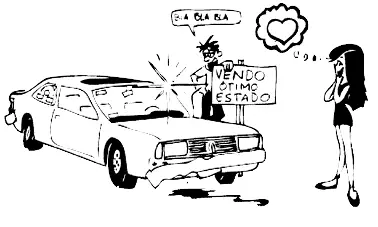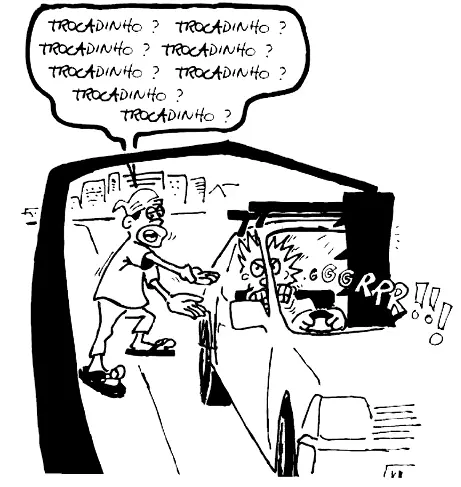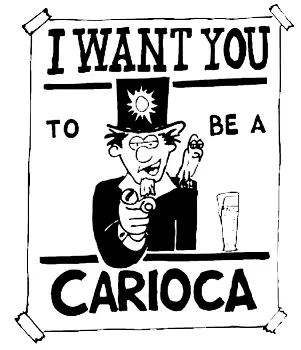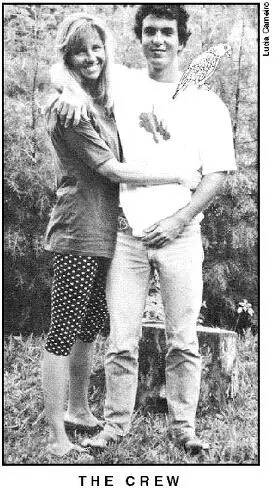
It’s simple. If she has worked for you for a year and a month, all you have to do is calculate one and one-twelfth month’s salary plus one third bonus minus her share of social security for her vacation pay, then add another one and one-twelfth month’s salary to cover her thirteenth-month salary, then calculate and add the stipulated percentage of her social security and mandatory retirement fund you have been depositing in the bank for her every month (plus fines in case you plum forgot or the line at the bank was too long), plus a full month’s salary for severance pay to top it off. Got it? The grand total will probably be enough for her to put a healthy down payment on that house in the suburbs she’s always wanted.
If you are a real Carioca, your best bet when purchasing a car is something used — at least five years old — preferably with a few dents and rust spots. That way you will avoid any nervousness on the highway or when parking, and the chances of it ending up for sale in Paraguay are «slightly» reduced.

Once you get the keys, the following recommendations may help you maximize the life expectancy of your car:
Always lock your steering wheel with a large padlock and turn on your alarm systems whenever you park;
Make sure that the most important item in your car, your horn, is in perfect working condition;
Place eight stickers on the windows and two beach chairs and a beach umbrella in the trunk;
Replace your antenna with a wire coat hanger and install your tunes in the glove compartment. (Or use your iPod!)
Being a Carioca, paying your bills is a breeze. (Refer to Lesson 7, «Dealing with Money.») If you’re not into on-line banking, or you simply don’t have a PC, no sweat. Just grab your utility bills, along with that grocery list and some change for your weekly fézinha(refer to Lesson 18, «Gambling — Legal and Not So Legal»), and head for the nearest supermarket or casa lotérica, most of which will be happy to handle your bills at the checkout counter.
And remember, since all other payments and overdue bills must be paid at the bank (refer to Lesson 19, «Famous Carioca Lines»), be sure to take along some trocadinhofor the flanelinhas, tennis ball jugglers, windshield cleaners, biscoito de polvilhoand tangerine vendors, etc., who will be waiting for you at every corner.

Your maid quit, the phones don’t work, the electricity is off, your tennis shoes were stolen, and your car won’t start? No problem. Fique numa boa(Stay cool), and do as the Carioca does. Put on a smile, slip into those Havaianas, and head for the sand. After all, there is nothing that a few hours at the beach won’t cure. Take it from a real Carioca.
Falou!(All right!)
Valeu!You bought this book and have read it to the end (or you started at the end and don’t have a clue what it’s all about). But if you got this far, have studied the lessons diligently, and passed the test, you are probably feeling a «bit» like a stranger in your own land. That being the case, you might be a Carioca and not even know it. Chocante!
Anyway, I sincerely hope that reading this book has helped you get over any rough times you might have had being a tourist in Rio. I never said it would be easy. Just remember: I wouldn’t trade this city for any place else in the world. It’s my city and I love it.
So, if the thought of going back to wherever you came from isn’t leaving you numa boa, pô, Rio could be your city, too. Varnu nessa, mermão!Call the folks, and put your house up for sale. And when you get back here, don’t forget — Aparece la em casa, viu?

Graphic designer, pianist, and mother of two grown sons, Priscilla Goslin is a natural writer. Born in a small mining town in the northern woods of Minnesota, she found herself on Ipanema beach for the first time at the ripe age of six weeks. Having made Rio her home for more than thirty-eight years, Priscilla attributes what she refers to as her cultural schizophrenia to the dichotomy created by her inherent sense of order and her fascination for the chaos only a passionate city such as Rio can offer. As she says, «Being a tourist is a state of mind, and I’ll confess to often feeling like a tourist in my own country. Now if I could only figure out which country that is…»

When not catching waves off Barra beach or strumming his guitar, Carlos Carneiro can be found strapped into a cockpit in either Brazil, England, or the United States risking his neck as a race car driver. A bona fide Carioca — born and raised in Rio — his artistic talent was first recognized by his high school principal who, obviously not amused by Carlos’ creativity, suspended him for drawing on the school’s books, wall, and furniture. To this day Carlos still can’t figure out how he got finagled into leaving his helmet on the shelf long enough to illustrate this book. But as he concedes, «I’d even draw pictures on Sugar Loaf Mountain if it would help finance the next racing season.»

Many thanks and much appreciation to Carlos Araujo for his editorial assistance; to John Gluck for his humor; to Amy Hunt for her proofreading; to Chick for his creativity; to Shane and Sundance for putting up with the madness; to Gary, Diana, and Pat for their feedback; to Carlao for being a real Carioca and without whom this book would never have been possible; and eternal thanks to my parents, Helen and Finley, for their love and support, and primarily for getting me to Rio in the first place.




















